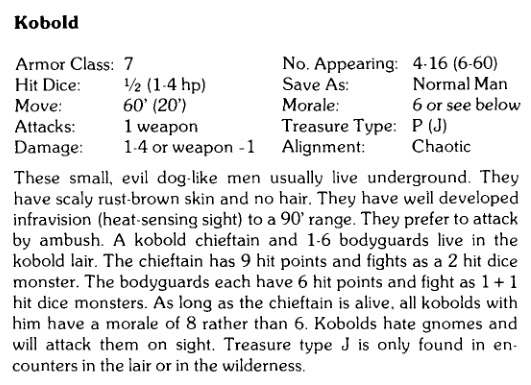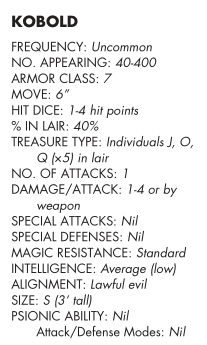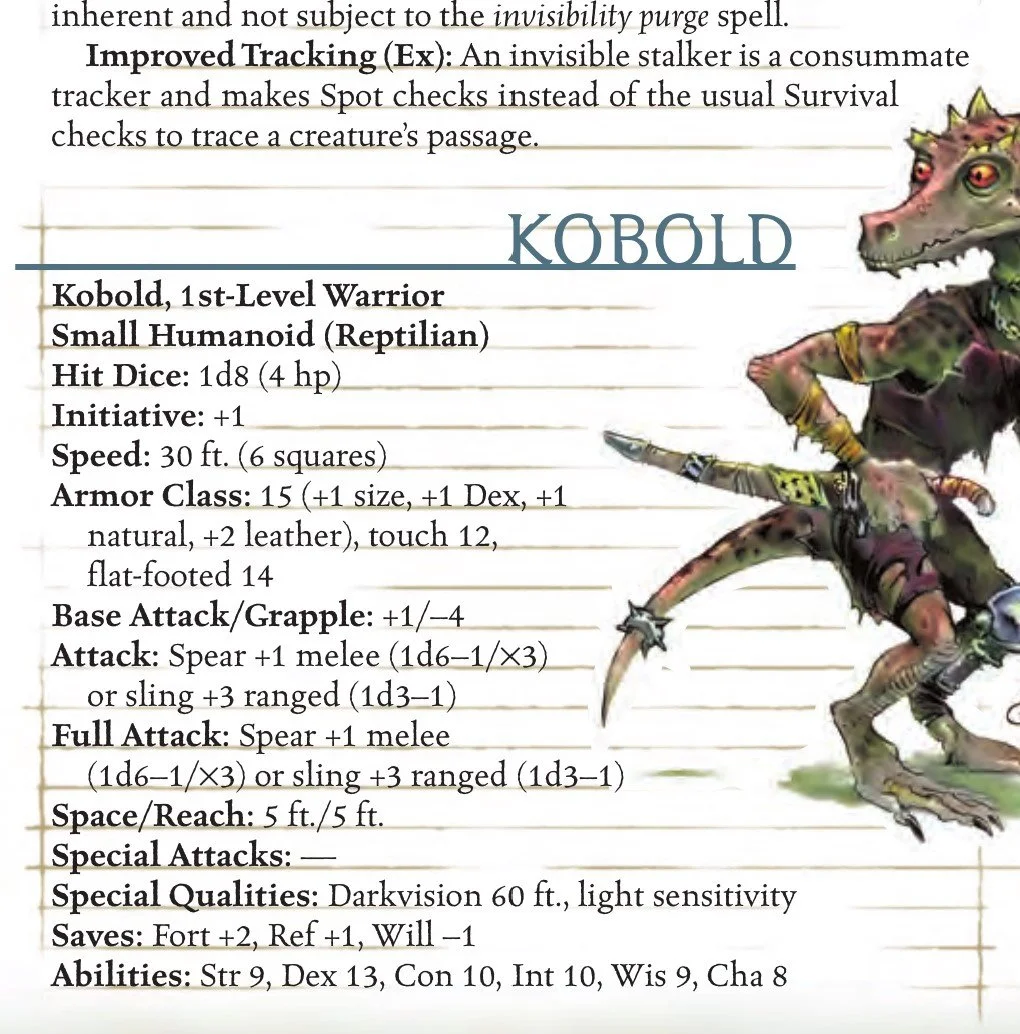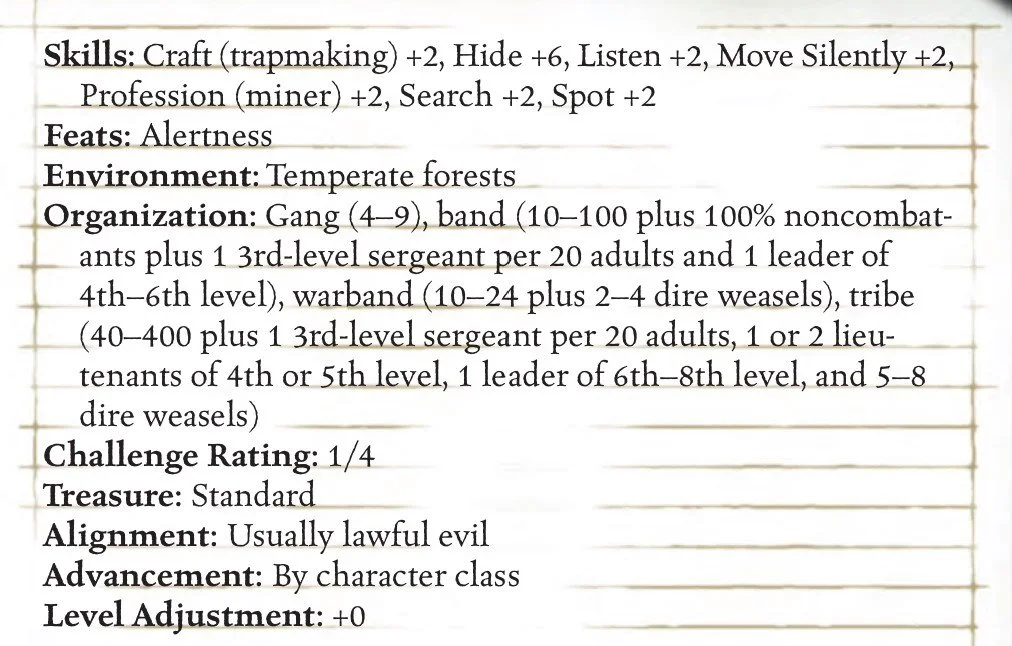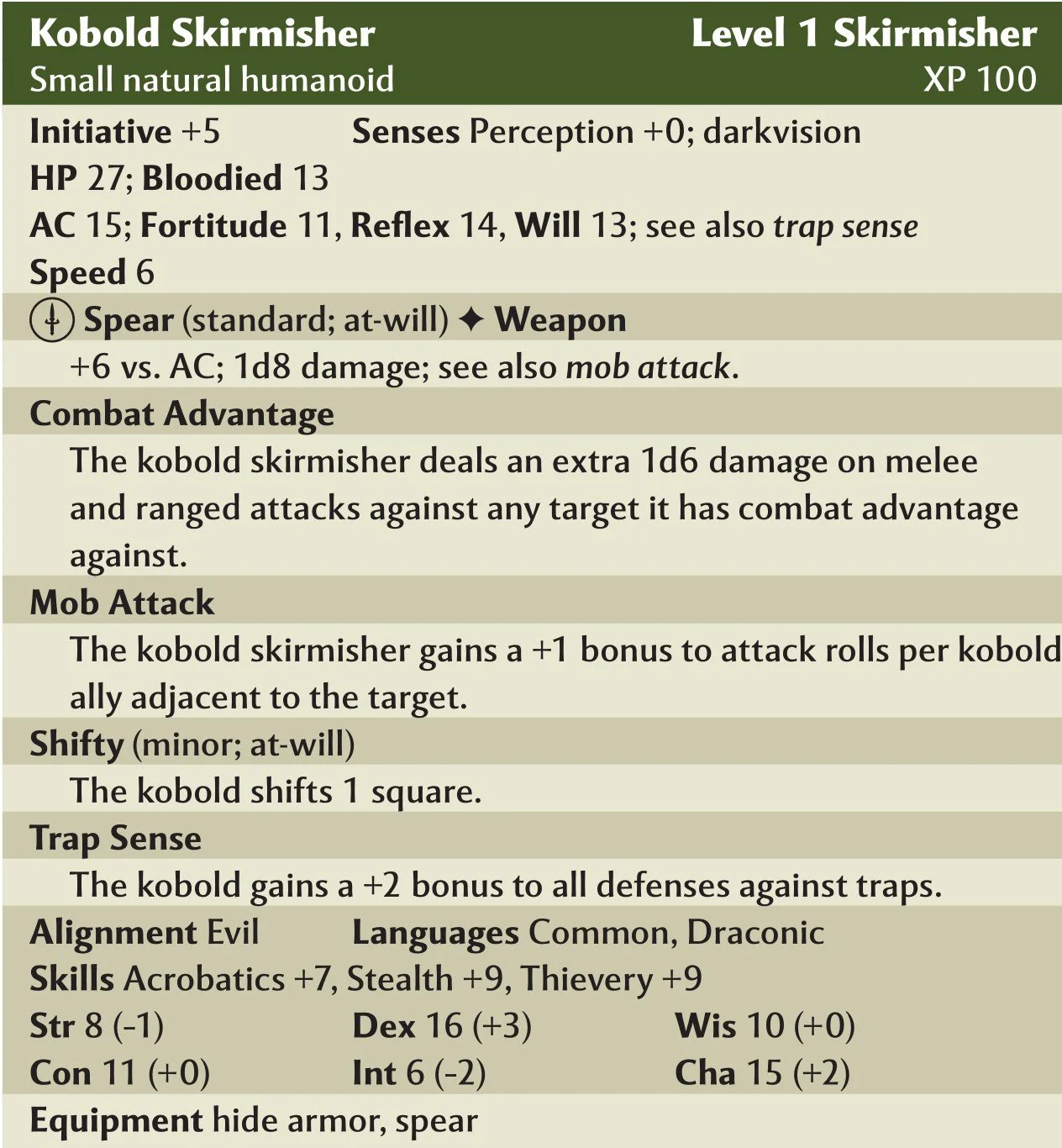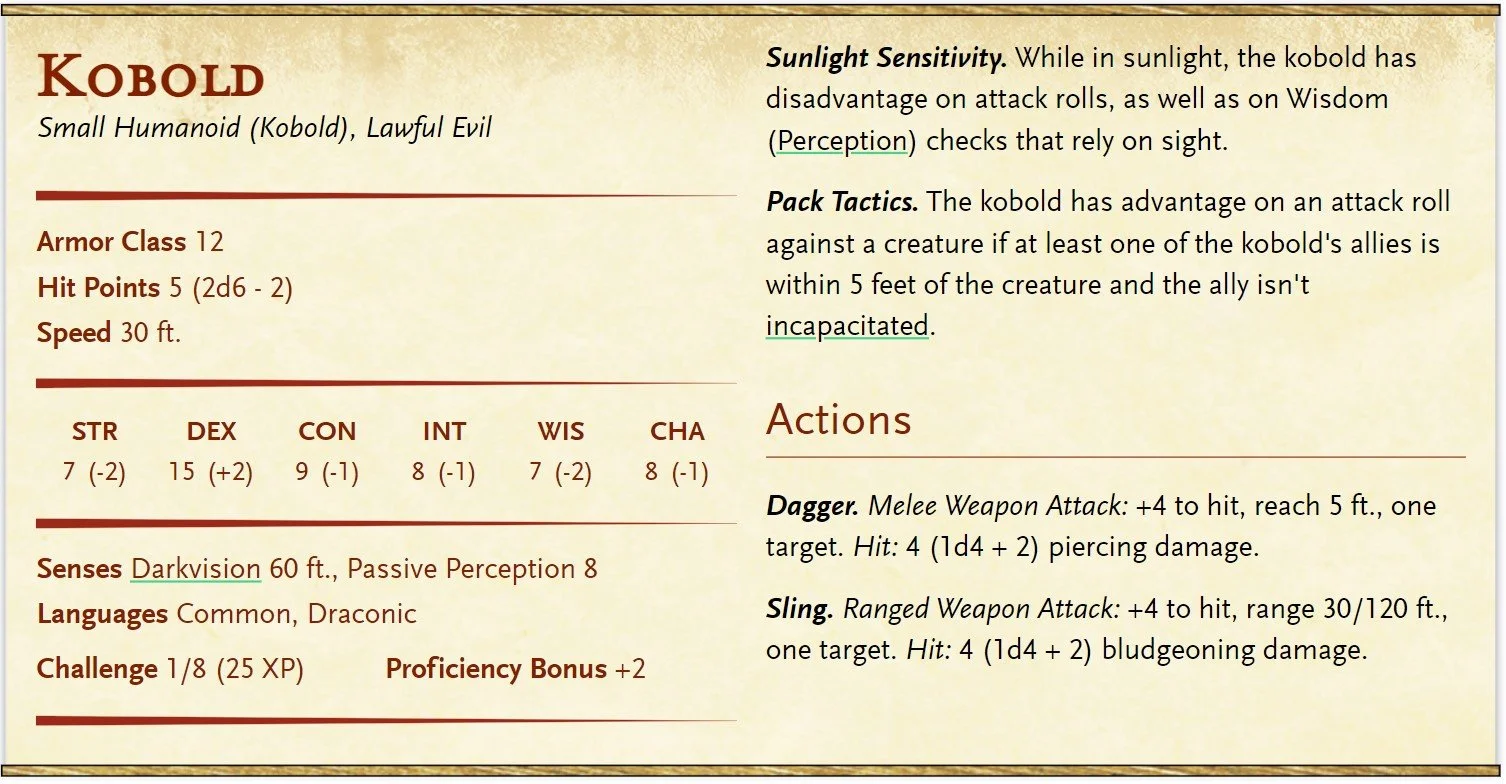Stat Block Deep Dive
A few weeks back we went through 5e’s stat block design because people sometimes ask me questions about how things work, how do you get specific numbers, etc. But this kind of brings up a problem that I have… the stat block just isn’t that interesting and we can improve it - or at the very least, create a stat block that some GMs will find more helpful.
Everyone is going to have different opinions on what makes a stat block useful and people are going to find different types more helpful than others. To get a better idea about stat blocks, this post is going to follow the transition of stat blocks throughout the editions and we will see what works and what doesn’t.
Original Dungeons & Dragons
Dungeons & Dragons - Volume 2: Monsters & Treasure, 1974 TSR Inc.
Dungeons & Dragons - Volume 2: Monsters & Treasure, 1974 TSR Inc.
The original edition is pretty… rough. Not only is the information broken up into two places, and by the time Greyhawk (1975) comes out, it’ll be broken up into four places, but the information provided just isn’t that good. In addition, certain monsters like the lovely kobold above, doesn’t even get their own statistics, instead, it is hidden in another creature’s statistics.
Actually, let’s go ahead and see what the Goblin stat block even looks like.
Dungeons & Dragons - Volume 2: Monsters & Treasure, 1974 TSR Inc.
Getting very strong “your princess is in another castle” vibes. This is part of the problem with the role-playing game at the very beginning of its life. It was such a small, close-knit community of wargamers, that it was just assumed you had other games already at hand. In this case, CHAINMAIL was a wargaming book that Gygax made in 1971, but in truth that was just a hack of another wargame called Siege of Bodenburg (1967) by Henry Bodenstedt. Originally, Siege of Bodenburg wasn’t a fantasy wargame, but tried to be historically accurate. Gygax is the one that mixed those fantasy elements in with Chainmail.
Luckily, I do have a digital copy of Chainmail… don’t tell anyone. So let’s go ahead and see what that looks like for goblins.
Chainmail, 1971 TSR Inc.
Alright, while we have a single source for a description, their statistics are actually spread out. They sometimes even appear in other monster statistics to let you know that goblins are the hated enemies of dwarves and dwarves will attack them first before any other group. What passes for a stat block in this edition is just wild and all over the place. Without going much more down the rabbit hole, let’s go ahead and talk about the best and worst thing in this edition before moving on to Basic.
Con
There is no unified stat block and everything is very spread out across a book that has a confusing writing style. Things are written down in the order that they came to Gygax’s mind, he doesn’t go back to add any new information he thought of, he just keeps plowing forward and never looking back. This could be because of technology, but it does make running a monster a rather confusing mess where you have fingers in half a dozen different places in the book as you try to remember all of the creature’s statistics.
Pro
I guess you have to start somewhere and this is where we start.
Basic Dungeons & Dragons
Moldvay Basic Set, 1977 TSR Inc.
Now we are getting somewhere. This actually, kind of, looks like a stat block that most people would be familiar with. Though, I will point out that this is from the 1981 Moldvay Basic Set, not the original 1977 Holmes Basic Set. The Holmes edition lacks as much information, but it largely looks the same and I’m only picking Moldvay because I find it easier to parse (and the statistics aren’t split across two pages due to a pagebreak).
Looking at it, we have key information consolidated into one location like AC, HP, movement, and more. It’s great! Though I have two problems with it. First, the saving throw thing just states that the kobold saves like a Normal Man, which means we have to find the saving throw chart somewhere in the book, and there is game information in the paragraph of flavor text.
The kobold isn’t too bad about hiding game statistics in there, but there are some monsters where they have a special move and it’s just buried in with information about its ecology, which makes it hard to run that creature quickly and effectively.
Con
Information is still split up across the book and they hide special abilities and attacks within the basic information paragraphs, so it can be hard to find that information when you are running a game.
Pro
Most of the information has been consolidated into one place, which is a great innovation and huge quality of life improvement.
Advanced Dungeons & Dragons (1st edition)
Monster Manual, 1977 TSR Inc.
Weirdly enough, the Monster Manual is released in September of 1977, but the Player’s Handbook and Dungeon Master’s Guide aren’t released until June 1978 and May 1979 respectively. I’m not entirely sure why they just released the Monster Manual as the first and only book in the new Advanced Dungeons & Dragons system instead of the Player’s Handbook - but they did. I’m sure it came down to budget, time constraints (since Gygax was the main author on all of them), and that you can use characters from the original ruleset but still. Seems weird to do the Monster Manual first.
The stat blocks provided are quite useful, with more information, though we still run into the problem that special attacks and special defenses are hidden within the ecology information of the monster. For those monsters with special attacks and special defenses, there is no clear delineation within their ecology paragraphs, and so you end up having to read through a paragraph, or two, or seven (in the case of the kobold) to get the information that you need.
This is kind of compounded by the fact that every monster is given a lot more information than they did in Original and Basic, so hopefully you read through everything before the game starts and you have a great memory.
I do appreciate, though, that even if a creature doesn’t have special attacks or psionic abilities, it does state Nil next to the entry instead of removing the entry completely. While that would’ve given them more room for more monsters, it would be slightly confusing and make it harder to quickly scan a stat block and find what you need.
I’m also a fan that it provides a “No. Appearing” so you know how many kobolds to use against your party. Though, that number is confusing. A party of adventurers aren’t going to fight 40 kobolds at a time, let alone 400. So you would think that pry means that many in a dungeon, but the Monster Manual states that “It is not generally recommended for use in establishing the population of dungeon levels.”
So like… what is that number good for then? Just as a fun fact?
Con
Stop hiding so much information in paragraphs of the monster description. But, because I’m sounding like a broken record, reduce how much shorthand used in the stat block. Different move speeds have different symbols, like fly is any number that follows a ‘/’ while swim speeds are after ‘//’. There is even a web speed which is the number after a ‘*’. Just spell it out.
Pro
It’s neater, it’s tidier, and it is easy to find the information you need so long as it is the basic information about the creature. In addition, I really like the rarity of monsters, how many may be in a generalized area, and other bits and pieces - though I would appreciate even more clarity.
Advanced Dungeons & Dragons (2nd edition)
Monstrous Manual, 1993 TSR Inc.
Our next edition is very similar to the previous one, probably since 2e was marketed as more of a 1.5e than as a true change in edition (and even then, 2e got an update a few years into its lifecycle, so really its like 1.75e).
It’s a bit cleaner to look at, bolding the different parts of the stat block was a good idea for legibility and I like some of the new additions. I love the idea of adding in the Diet of each creature, though it does seem a bit silly adding it into a stat block (but maybe every Monster Manual should make sure they state what a creature eats…?).
Con
Without repeating myself about hiding unique abilities, I am going to talk about the Hit Dice. Instead of telling you how many hit points, on average, a creature might have - they just give you the number of hit dice and you are to roll a number of d8s equal to that number. Or, if you look up over at the Urd, they give you a range for its hit dice that it might, which is 2-5, or 1d4+1 hit dice. So you first have to decide how many hit die it has, then you get to roll the d8s, add them together and come up with the creature’s hit points. You then get to do that 3 to 300 times for all the urd the party might encounter. Obviously no one is determining, by random dice throwing, the number of hit points for 300 urds, but it just seems so weird to set it up this way. Just provide the average hit points and leave a note at the start of the book that the provided hit points are a suggestion and GMs can do whatever they want.
Pro
It is so much cleaner to read that it makes quickly finding a specific value very easy to find. This is carried over into the monster’s ecology and general information with specific headers for Combat (so you can find special abilities quickly), Habitat/Society, and Ecology.
Dungeons & Dragons 3rd edition & v3.5
Monster Manual, 2002 Wizards of the Coast
The kobold’s stat block is starting to get much better and not just because they finally look like little dragons instead of weird dog/rat things. While their stat block is split across the columns (which is not something I like), you can quickly find what you need. Unfortunately, special abilities and the like are still reserved for their ecology paragraphs, but it is clearly denoted down there and is easy enough to find.
Monster Manual, 2002 Wizards of the Coast
When you get right down to it, though, there isn’t actually that much new in the stat blocks. We get ability scores (besides just Intelligence that we got before), skills, break down of organization, as well as key words like humanoid… weirdly enough, there seems to be a misprint since Kobolds are ‘reptilian’ instead of ‘draconic’. I’m sure that was just an oversight.
Con
While it is a formatted list with good use of bolding keywords, there still isn’t a clear distinction between a stat block and the rest of its information. When you look at a page, it just looks like word vomit between the stat block and the monster information, and is harder for you to parse through it all before you can start understanding any of it- it also doesn’t help that monster statistics will just jump pages and columns, making it hard to properly run the monster since it isn’t consolidated to a single place.
Pro
Third edition is kind of the ‘modern’ stat block, even if it is formatted like the previous editions. It just offers more detailed information than before, like having its hit points broken out, its attacks written in a clear form that is easy to glance at, as well as providing the creature’s saving throws right there for the GM to reference instead of referencing charts in a different book or on their GM screen.
Dungeons & Dragons 4th edition
Monster Manual, 2008 Wizards of the Coast
This is probably my favorite stat block. It is easy to find on the page, it has everything you need to know about the monster, and is pretty well organized. This is a stat block to be inspired by.
First, everything you need to know about the monster is there. If a monster has a spell-like ability, it is written out in the stat block and you don’t have to scrounge in another book or try to remember how many d6s you have to roll for fireball, it’s max range, or just how much bat guano you need to cast it.
In addition, extraneous things are removed, like environment, how many are in a lair, what their diet is, and more. Everything is stripped down so you have the most important information up front. Though, with that said, it is a bit sterile in its presentation of the monster which some could find unfriendly.
Con
My major criticism of 4e’s stat blocks is not really something to do with the stat block, but rather the monster’s information. In the Monster Manual, you are lucky if you get a whole paragraph about the monster, let alone a few sentences. The monsters are presented mostly as stat blocks, which means you have to spend a bit of time studying the stat blocks to learn about the monsters and glean how they might function or behave.
Pro
Everything you need to run the monster is there. Nothing is hidden. It is wonderful to just have everything you need for the monster in front of you without having to dig into another book. This is probably the most important quality in a stat block, but it is limited by the game system. If a game system has a bunch of spells, the monsters are going to have those spells to use, which means you either rewrite all the spells on the monster stat blocks (which would be a beast), you pick only a handful of spells to write in fully in the stat blocks, or you don’t give your monsters spells, but rather unique abilities.
Dungeons & Dragons 5th edition
Monster Manual, 2014 Wizards of the Coast / DnDBeyond
The latest edition, 5e takes lessons from every edition but does have its own thing going on. The stat block is clearly delineated from the rest of the information on the page, you have hit points broken out, and you have abilities separated from its general actions, though we now get large lists of spells which means we are back to referencing other books to remember how things work.
While it is a good stat block, as it should be after several renditions we have looked at today, it still isn’t perfect. I have some bones to pick with it, there is information we don’t really need on there (like ability scores), and I’d like to see a few things move about so that we can focus on the important parts you need when running the monster in combat.
Con
The biggest con I have is that not all of the information you need to run the monster is in the stat block. This is mostly to do with spells, which I understand. That problem does kind of get fixed as the stat block evolves in this edition so that you have fewer spells in the stat block and more unique abilities, but I still find it irksome. The other issue is that we are keeping too many sacred cows in the stat block, like ability scores, that we don’t need.
Pro
It’s clean, it’s simple, and it’s easy to find what you need. It is quite speedy to quickly gather up what you need, so it’s easy to use and you don’t have to worry about being surprised by too many things if you just give it a quick glance before you begin your session or combat.
A New Stat Block
With our review of all of these stat blocks, it’s easy to see how stat blocks are getting better and better, making it easier for a GM to quickly grab a monster and run it through its paces before the table inevitably rips the monster apart. With this background, I think we can a great stat block - though, everyone is going to be different.
Are there pros or cons I didn’t mention that you like in the different stat blocks? Share them down below!
Like what we are doing here?
Support us on Patreon!
You’ll get early access to deep dives, the Homebrew Hoard featuring 500+ monsters, Monster Thursdays, ad-free articles, and more!
Follow us on Twitter to keep up to date on everything we talk about!






